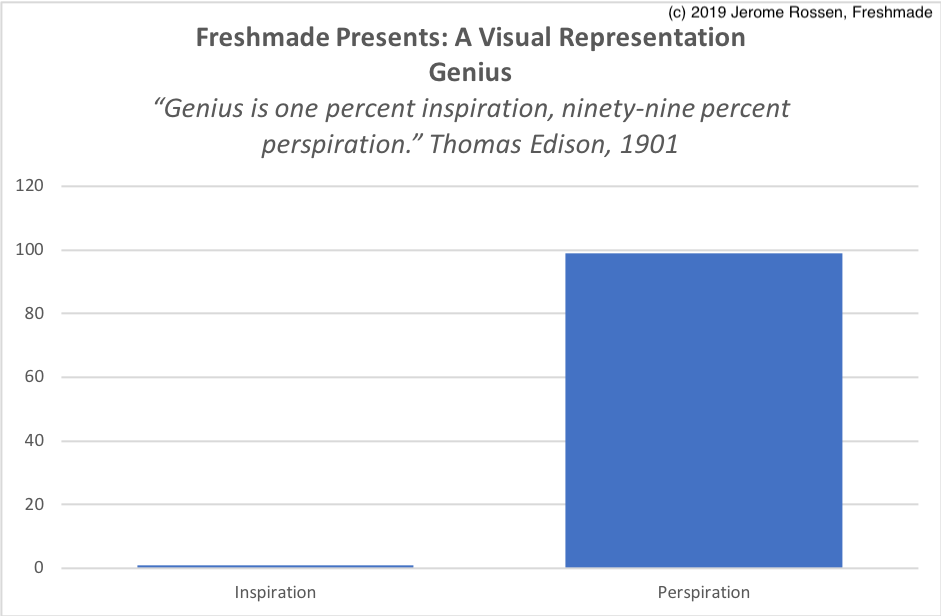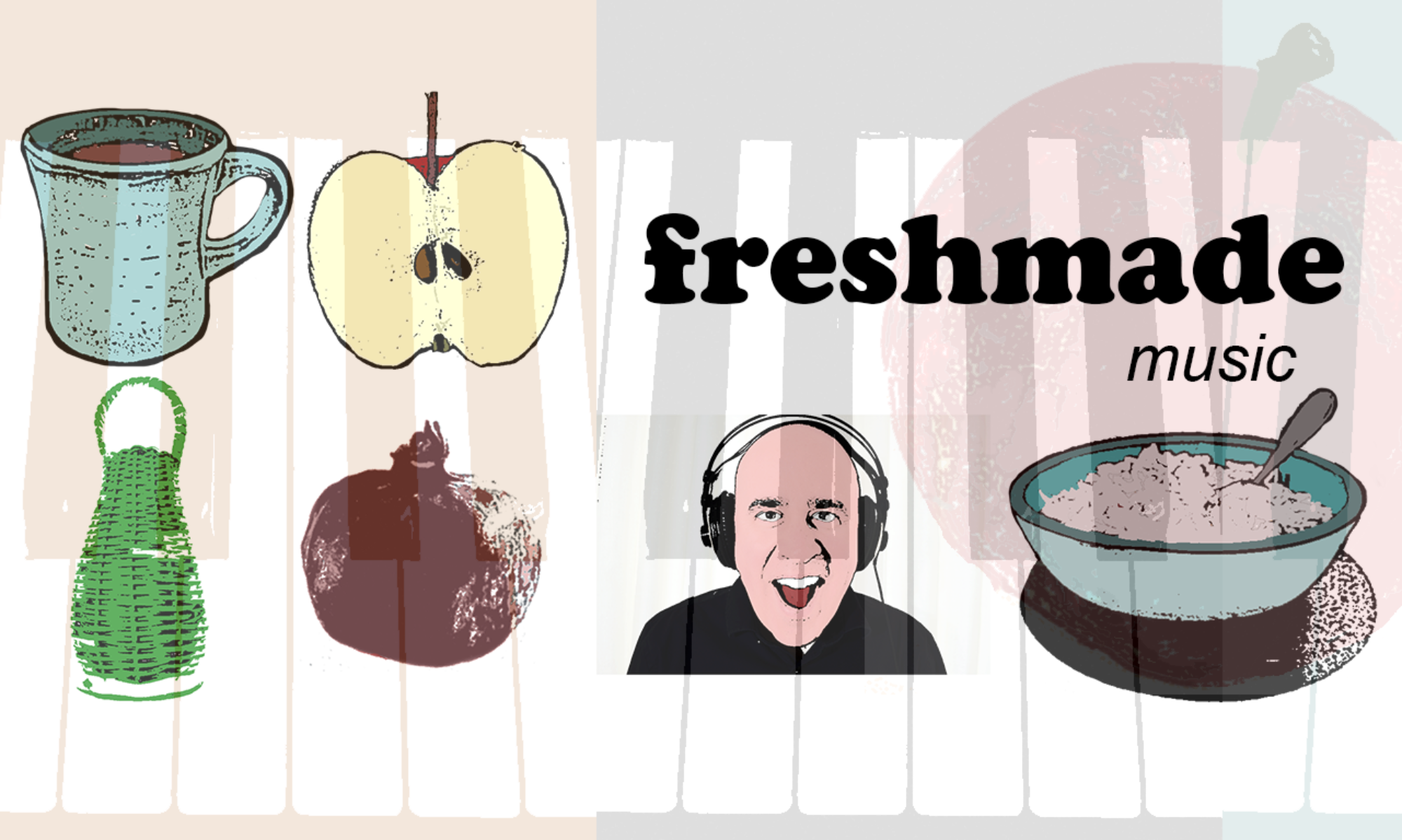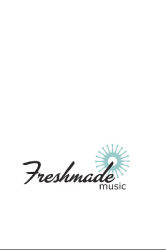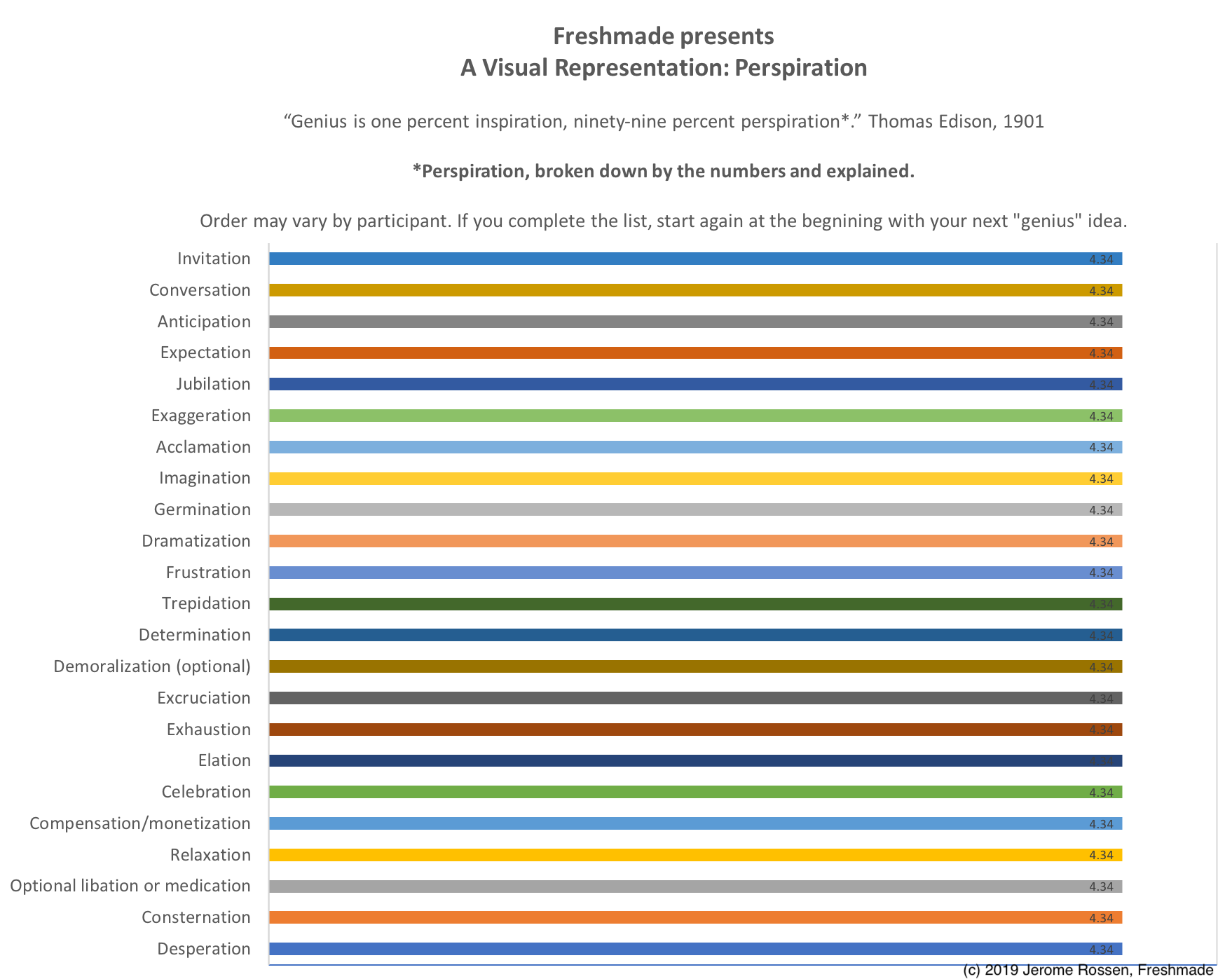“Genius is one percent inspiration, ninety-nine percent perspiration*.” Thomas Edison, 1901
Freshmade presents – A Visual Representation: Genius
“Genius is one percent inspiration, ninety-nine percent perspiration.” Thomas Edison, 1901

Seven Steps of Creativity
Creativity can seem elusive. For some people, it’s loaded with fear and superstition. The fear is that just by asking, trying to look the muse directly in the eye, we risk scaring the muse away!
With a little bit of faith in my heart and my fingers firmly crossed, I took some time to examine my creative process. I was somewhat surprised to learn that I go through a similar process each time I complete something creative. In my examination, I broke my creative process down into steps. Here are:
My 7 Steps of Creativity are: the spark, organization, the brainstorm, assessment, execution, revisions, declaring it done.
I realize that there are likely tons of really great ways to approach creativity effectively and there is probably no real magic to the way I personally approach creativity. This just happens to be mine.
I notice that I don’t always use each of these steps in order — sometimes I skip around a little bit, but I do touch on each one at some point. I’ve outlined a brief explanation of each of the 7 Steps below and I’m including some tips on how I try to optimize each one.
How can you use these steps and how can they benefit you? For me, I use this process for writing articles, producing music tracks, writing songs, and collaborating with other creative folks. This process may be helpful for you if you’re working on a large project that you need to tackle but seems daunting, or if you’re trying to figure out the best way to start a project — perhaps you’ve got a temporary case of writer’s block ? And why don’t we just assume that all writer’s block is temporary?
1. The Spark
The Spark is that kernel of an idea that seems to magically enter into your head. Sometimes the spark comes quickly, in the shower or when you’re driving — hopefully not when you’re trying to do both! But sometimes you have to will it into existence. Either way, you want to be ready when your great inspiration arrives. Here’s what I recommend:
Optimize Tip: Create your space
The idea here is that you want to open the creative space in your mind for the spark to come. A free mind is an inviting environment for creative ideas.
Do whatever you need to do, both mentally and physically to make sure your mind is free of distractions. When I have a lingering bill, phone call or email to write, then I take care of it, especially if it means it will free up more room in my brain to be creative. I can be easily distracted from checking my email and checking into social media, so I create some guidelines for myself.
I don’t like to begin work until I have an organized work space. If it would help you to have a clean work area, then set aside some time or put an action plan together about how and when you’re going to clean your space. And if you have to, find somewhere else to work, like your local coffee shop.
A note of caution here — if you find that the “create your space” step is taking more time than you expected (“Oh, my 5th grade class photo… I wonder where Desmond is?”) than be careful that you’re not using this as a reason to procrastinate.
2. Organization
When I was just starting out composing music for film and TV, I would have a tendency to jump the gun and start making stuff way too early in the process — right after getting the spark — without having nearly enough information. I would make a number of assumptions and then be prepared to deliver music based on these assumptions to my clients. As you might imagine, many of my assumptions would be wrong, my music wouldn’t be quite right, and in the very beginning, my ego was a bit bruised. If I had been a little more patient and just asked questions and listened to the answers, I would have been in a much better position.
Optimize Tip: Gather information by research or listening
Answer who, what, where and when. This is when you’re the project manager; where you identify what you’re doing, how you’re going to do it, who’s responsible for what, what your deadlines are and whether there are any additional resources that you’re going to need. If you’re working with clients, this is the part where you listen to how they understand the project, you ask lots of questions, and you clarify whatever you need to. For many creative projects, it’s often clear in somebody’s head what creative solution will work — if you’re working for that creative person, you want to make sure you get the full creative download on what they’re expecting, so it becomes clear in your head too.
While capturing all of these details may sound stifling, most creative folks thrive on having a structure so they know exactly what they’re working on. I personally love knowing what my deadline is, who my target audience is, who I’m working with, who will be reviewing my work, and what the parameters are for the project.
3. The Brainstorm
The point of the brainstorm section is to get lots of ideas together so that you can choose the best ones. Sometimes my first idea is good, but I’ve noticed that I can push myself to see “What else can I do?” or “How else can I solve this?” In situations where I’ve come up with multiple ideas, I’ve often taken elements from a few different ideas to find the winning solution.
Optimize Tip: Allow yourself to create without judgement
Sometimes when I’m writing a piece of music, I may write three really quick sketches knowing that I’ll assess them at a later time, and honestly not really worry about whether they’re good. This is the time for creating content, not judging it. It’s critical in this stage to turn your editor off so that you can freely express your ideas without the little voice inside you constantly saying “no, that sucks” or “people are never going to like this.”
4. Assessment
This is when you can let the editor in and freely judge the brainstormed ideas. For me, I really appreciate starting the assessment process after I’ve had some space from the initial brainstorming session, whether it’s overnight or after I’ve taken a brief break from creating. This way, I can try to have a fresh perspective, and I can try not to be emotionally attached to any one idea.
Quick note — while the assessment step may take place here, and it may take place again, later in the process.
Optimize Tip: Try to be your own fair, balanced critic
The sooner you can be honest with yourself, the better. If you really like something you’ve created, and you’ve gotten positive feedback from folks who understand what you’re doing, there’s a good chance that some group of folks out in the world will like it too. But if I create something, look at it a few days later, and I’m not in love with it? I give myself permission to to step away and start again, especially if I don’t know how to make changes so that I’ll love it. Sometimes the quicker that you can judge that something won’t work can save valuable creative time to focus on the ideas that you think are worth pursuing. Besides, I always keep all my work — even the discarded ideas because sometime those so-so ideas get revised and turn into great projects.
5. Execution
Optimize Tip: Create fast and cheap prototypes
You want some way to be able to really quickly assess the viability of your idea. Sometimes you can only see a dramatic flaw from a mockup that you can’t see on paper. I record demos and listen. I audition instruments and see how they’re working together. If it’s appropriate, I get feedback from trusted sources. Again, it’s often helpful to allow yourself to experiment, fail and revise in this step.
Optimize Tip: Try 3–5 versions
Put together 5 beginnings. Create 3 endings — quickly, but don’t polish them yet. You want to put only enough energy in to see whether your project is working. If it isn’t, create some more. If it is, and all it needs is polish, then that’s fantastic!
(At this point, I often go back to #4 Assessment)
6. Revisions
If you have an inkling in your gut that you should change a small part of your project, do it and see if you like it better. In the majority of these situations, a small change might take a little more time to fix, but is totally worth it in the end.
Optimize Tip: Revisions can make or break the project
Sometimes it’s easy to blast through the initial creation phase of a project, but I notice that I slow down for the analysis portion. I often find that analyzing projects to figure out how to improve them can take much more time, and can be a much more delicate process. Very often a few very small changes can make a big difference in a project. When I’m working on a music track, I try to listen to reference tracks to make sure I’m getting the mix that I’m trying for. During the brainstorming and execution steps, I may make broad strokes. In this revision step I’m more conscious of working carefully and more skillfully.
7. Completion — Declare it Done
Sometimes you have an external deadline when you have to turn in your work, so that whatever you’re working on can go to the next step. And sometimes, creatively you need a break — you’d like to wrap it up and start something else.
Optimize Tip: Try to get it finished “enough”
There are times when I’ve finished a project because I’ve run out of time. In fact this can sometimes be a blessing. There are projects that come together very quickly — 90% is finished in a day or two, then I take 3 days to try to polish the last 10% (See the Revisions Step above). Be careful with how long you take to complete the final polish. When you think a project might be done — get some feedback if you need to, take a deep breath, do one last check, then pitch it, send it, ship it — whatever needs to happen. Then move on to the next project (and perhaps start again at step #1!).
Creating something can be a pretty messy process. In my mind, I come up with an idea, work on it, then it’s finished. But when I stopped to examine my process, I realized there is a lot more to it. I also realized that I don’t generally bring superstition and fear into my creative process when I’m mindful of following the 7 Steps of Creativity.
If you have any interesting tips to share about your creative process, or if you have any questions or feedback about these 7 Steps, I’d love to hear from you. I’m always fascinated to learn about how other folks approach their creative process. I’m especially interested to see how other folks start and finish creative projects. Go make stuff!
Jerome Rossen is a composer, songwriter, producer and professional musician. For 15 years, Jerome has created music for advertising, apps, and kid’s video games. Jerome has placed his music in major TV shows on NBC. ABC and Fox. Jerome also creates the music for the Happy Tree Friends, a very funny (though very violent) cartoon for adults and mature kids, with a huge cult following. He runs Freshmade Music, an independent audio studio. You can learn more at www.freshmademusic.com.
I’m A Thinker – Collaboration with 1st Graders
I had the great pleasure to collaborate with these 1st graders to write a song about thinking. In this hyper-speed age we live in, it’s remarkable to get this great reminder to slow down… from 1st grades no less!
This video shows the first part of the song.
And here’s the chorus:
“I’m a thinker, yes that’s me
I observe the things I see
I imagine and I wonder
About my community
I’m a thinker, yes it’s true
You might be a thinker too
We find answers and solutions
Because that’s what thinkers do”
fb.me/9qt1attfZ
Faders – Career Ideas: 5 Tips for Creative People Who Excel at Multiple Things
Over the last few years I’ve attended a couple audio and music industry conferences where I’ve participated in panels discussing careers and networking. Here is a question that has come up a few times…
Allen (who’s name I have changed) asks: “I’m a musician, engineer, producer, sound designer and songwriter. I’ve had a job assisting an engineer for a couple years, but I’m not sure I want to keep doing it. I think it might take a couple more years until I’m sitting in the engineer chair, but I don’t know if I want to wait that long. I think I may want to do something that feels more creative. What should I do? How can I do all of those things?”
My answer… yes and maybe! My favorite analogy is that of a mixing board with faders. In Allen’s case, there are 5 things that he wants to do – and let’s assume he does them all well. First things first – we need to take a step back and recognize that he’s done something well enough to convince someone else to pay him to be an engineering assistant, and presumably he’s paying his bills with a job, that is at least related to what he wants to do. Good job, Allen!
With our fader analogy, we’re going to assign each of the things Allen wants to do to a fader. Our goal is to bring up all the faders, and make it sound good. Sometimes Allen might bring a few faders up and leave a few down. It’s possible that he never has them all up at the same time. Right now, you could say that the engineering “fader” is mostly all the way up, and all the others are down – but as Allen has expressed, this is not exactly what he wants to do.
Would it be possible for Allen to bring the producing fader up a bit? Can Allen focus more on producing during the evening and weekends, while he keeps his current job? Does he have after-hours access to the studio? Can he bring artists or other projects in during these times?
What about some of Allen’s other interests? Does he have buddies that he’s in a band with, and can he bring them into the studio? Does he have friends making records elsewhere? Do any of them need songs or musicians? That could cover being a musician, engineer, producer and songwriter.
While Allen might be impatient to make a career switch, we should recognize that his experience as an engineer will be an asset to any other project he enters into. Also, it’s important to note, that since Allen is already otherwise making his living, it’s not essential that he make money from these other activities right away. It’s more important to build his network, credits and track record. For example, it would likely be better for Allen to have produced, engineered and mixed three of his friends bands – and for those to sound awesome, then for him to hold out for too much money and not have produced anyone, thus not having anything for prospective clients to check out.
Which is not to say that Allen should work totally for free (ever!), even for friends. In this era of KickStarter and PledgeMusic, it’s possible for a band to raise some amount of money. Perhaps someone in the band can trade you for professional services like helping to put together a website or helping with PR.
While you may not share Allen’s specific skill set, hopefully you can see what I mean with the fader analogy. I have many creative friends who do quite a few different things really well. Some have decided to focus on one career path and then switch somewhere along the line; others have figured out a way to be more multi-disciplined. Please let me know if you have any comments or have an ideas that have worked for you.
Here are my 5 Tips for Creative People Who Excel at Multiple Things:
1. Pay your rent. You need to be able to cover living expenses, food, etc. If this means taking a day job – do it. For the vast majority of us, we’re much more functional creative humans if we don’t have to worry about day-to-day expenses and where we’re going to sleep at night. Also, make sure you have a solid plan of how to push your creative self forward if it ends up being on the evenings and weekends. Taking care of yourself first isn’t an original idea; it’s basically taken from “Maslow’s Hierarchy of Needs”. To learn more about that, check out: http://www.simplypsychology.org/maslow.html
2. Become a master. Start with one skill that you’re already good at and try to master it. Get help from someone who already does this better than you, whether it’s a formal teacher, a mentor or some learning materials.
3. Choose wisely. There are lots of parts of the recording, audio and music industries that don’t pay the bills, and they can be extremely competitive. Some of these areas feel like a lottery (in fact your chances might be better in some lotteries!). If there is a specific area of the industry that you’re serious about pursuing, make sure you are realistic about your chances, and make alternate plans in case your dream doesn’t bring money in, or doesn’t bring in money right away.
4. Plan for the long game. If you’re planning to be a full-time creative person, especially if you’re living in an expensive creative city, I recommend start with 2 years of living expenses and assuming that you will earn $0 from your creative work.
5. Be flexible. Sometimes a job in your industry that ends up bringing you financial gain or recognition is not the area that you set out to work in. If you end up with a specialty, don’t fight it!
Jerome Rossen is a composer, songwriter and audio producer. He’s also an educator, engineer, writer and professional musician! He usually has only one of his faders all the way up! He is best known as the composer for the Happy Tree Friends. Since 2005, Jerome has scored the music for this animated Internet sensation, recognized as the most-viewed web series of all time, with over 2 billion video views. You can learn more about him at www.freshmademusic.com.


